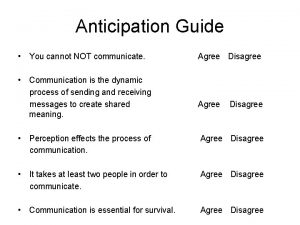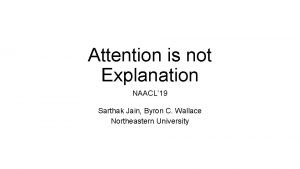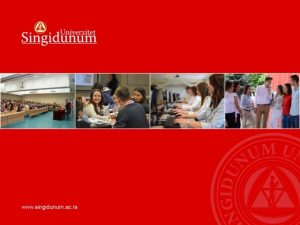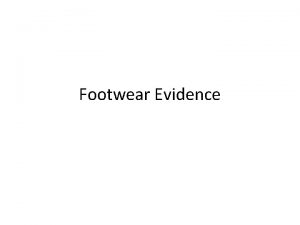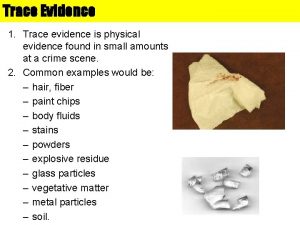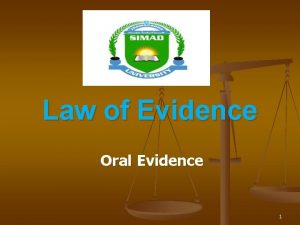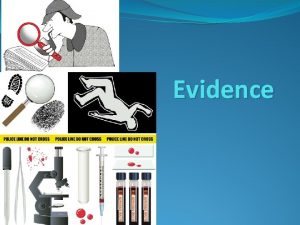When Evidence is not what it seems Complexities

































- Slides: 33

When Evidence is not what it seems: Complexities in the Assessment of Skin Antiseptics Matthias Maiwald Senior Consultant in Microbiology Assoc. Prof. , National University of Singapore Dept. Pathology & Lab. Medicine KK Women’s & Children’s Hospital, Singapore Presentation for Health. Watch USA, 19 July 2017 matthias (dot) maiwald (at) singhealth (dot) com (dot) sg 1

Conflict of Interest Statement • No conflicts of interest to report 2

History of Antisepsis Ignaz Philipp Semmelweis (1818 -1865) Joseph Lister, 1 st Baron Lister (1827 -1912) Image: Emerg Infect Dis 7 (2); 2001 Image: Wikipedia • Implemented hand antisepsis; i. e. reduction of microorganisms on hands 3 • Implemented wound antisepsis (precursor of skin antisepsis)

Skin Antisepsis – Definition and Relevance • Antisepsis = disinfection of living tissue (e. g. hands, skin) • Skin antisepsis reduces number of microorganisms on skin • Aim: to reduce the risk of infection or contamination from iatrogenic skin breaks Skin antisepsis already prevalent in early 1900 s 4 Charles Harrington, M. D. , and Harold Walker, M. D. The Germicidal Action of Alcohol. Boston Med Surg J 1903; 148: 548 -552. May 21, 1903

Starting around 2010, several colleagues and I noticed unusual things in the literature. . . • Articles compared trial outcomes from chlorhexidine-alcohol combinations (i. e. two active ingredients) to povidone-iodine alone (i. e. one active ingredient) • Concluded: “Chlorhexidine is better than povidone-iodine” • We tried to rectify this in letters to editors – little effect 5

Antimicrobial Spectrum and Activity of Skin Antiseptics Larson EL. Guideline, topical antimicrobial agents. AJIC 1988; 16: 253 -66 Mangram AJ et al. ICHE 1999; 20: 250 -78 (‘CDC surgical guideline’) E, excellent; G, good; F, fair; P, poor; SP, skin prep. ; SS, surgical scrubs • Alcohols are most rapid-acting & most effective skin antiseptics • CHX and PVI are less potent, but have persistency on skin (greater for CHX than PVI) • CHX-ALC or Iodine-ALC combination have advantages: additive effects, persistency 6

Questions arose: • What is the factual evidence for (a) chlorhexidine alone, or (b) CHX combinations, in skin antisepsis? • How common is the attribution of study outcomes to CHX alone when a combination has been used? • Could this phenomenon have unjustly skewed evidence-based guidelines? 7

Systematic Review Strategy Exhaustive search for primary & secondary literature: (1) Clinical Trials, (2) Systematic Reviews CHX versus competitors in: (A) Skin antisepsis for blood cultures (B) Intravascular catheter insertion (C) Surgical skin preparation Criteria for literature assessment: (1) Attribution of study outcomes from ALC+CHX to CHX alone? (2) Factual evidence for CHX --> meta-analyses Review of guidelines & narrative reviews 8

Potential Scheme of a Clinical Trial Active Ingredient 1 9 Trial Arm A Trial Arm B Clinical Outcome A Active Ingredient 2 Active Ingredient 3 Clinical Outcome B

Criterion for Assessment Attribution of study outcomes from CHG+ALC to CHG alone Articles concluding: “Outcome A is caused by Ingredient 1” “Ingredient 1 is superior to Ingredient 3” “The evidence supports Ingredient 1” Clinical Trial Active Ingredient 1 10 Trial Arm A Trial Arm B Clinical Outcome Active Ingredient 2 Active Ingredient 3 A Clinical Outcome B

PLo. S ONE 7(9): e 44277; 2012. doi: 10. 1371/journal. pone. 0044277 11

Main Findings (1) Good evidence that CHX+ALC is better than PVI aq. for blood cultures, catheters and surgery (2) However, CHX+ALC versus PVI+ALC equal or inconclusive (3) No evidence for CHX alone (!) for blood cultures and surgery (superficial skin) (4) Evidence that CHX aq. better than PVI aq. for catheters, but weight of evidence for CHX+ALC for catheters is better (5) Incorrect attribution of trial outcomes was common • Average 34% (btw. 29 -43%) of attribution incorrect • Plus ambiguous/unclear attribution: avg. 54% of articles not clear on what caused trial outcomes (6) Antiseptic composition often incomplete/missing • Only ~35% of all clinical trials and systematic reviews both (a) correctly listed the antiseptics that had been tested, and (b) correctly attributed efficacy to the components used (7) Led to unsubstantiated recommendations in clin. guidelines 12

Further Observations (1) About 65% of clinical trial and systematic review authors were not fully clear (or not fully aware) of what it was that they actually tested (2) Substantial misinterpretation of evidence occurred despite most clin. trial and syst. review authors adhering to formal evidence analysis and reporting requirements --> Knowledge of the subject matter at hand is a necessary prerequisite for assessing and interpreting evidence 13 Derived from: Maiwald M, Chan ESY. PLo. S ONE 7(9): e 44277; 2012.

Observed Errors, Pitfalls & Misinterpretations in the Assessment of Skin Antiseptics (1) Inadequate neutralization of antiseptics in microbiological efficacy tests (2) Incorrect attribution of efficacy (see earlier) (3) Statistical & other inaccuracies and errors 2 1. . 14

Importance of Neutralizers American Journal of Infection Control 41 (2013) e 1 -5 BMC Infectious Diseases 2005, 5: 48 doi: 10. 1186/1471 -2334 -5 -48 (. . . ) 15 • • • Requirement in standardised microbiological tests (US & EU) To prevent continued killing AFTER end of microbicidal testing Necessary for ALL antiseptics, but CHX particularly affected Failure may lead to FALSE-POSITIVE efficacy assessment Absent/insufficient neutralization common in literature

Statistical & Other Inaccuracies and Errors • Several examples in literature – includes: (a) frank miscalculation of statistics, (b) inappropriate groupings of trial arms, (c) selective reporting (unlike prespecified outcomes), (d) inappropriate in-/exclusion of trials in meta-analyses, (e) assessing trials w. unknown/insufficient antisept. content Impact of various Errors & Misinterpretations --> Disproportionately in favor of chlorhexidine • CHX is effective – but ‘disconnect’ with real benefits --> Created perception of CHX as the “IN” antiseptic • • 16 • Reasons are unclear – Possibly reflects heightened interest by CHX researchers But also research scandals & alleged industry ‘kickbacks’

BUT. . . Evidence for skin antiseptics does NOT arise solely from clinical trials out of a prior vacuum of information! US FDA Drug Development Pathway E. g. compound E. g. lab testing, discovery animal testing, etc. Various phases of clin. trials --> Multiple useful information sources before/outside clinical trials 17

Microbiological Antiseptic Testing (1) Tests in reagent tube format Bacterial suspension Disinfectant solution Shown is qualitative suspension test Source: Reybrouck G. Evaluation of the antibacterial and antifungal activity of disinfectants. Chapter 7. 2. In: Fraise AP, Lambert PA, Maillard JY (eds. ). Russell, Hugo & Ayliffe's Principles and Practice of Disinfection, Preservation & Sterilization, 4 th ed. , Oxford, UK: Blackwell Publishing; 2004 (neutralizer) (2) Tests on real skin (or hands, etc. ) • Antiseptic testing has a history of nearly 100 years • Increasingly standardized over last 20 -30 years 18 Source: http: //depositphotos. com/4583685/stock-photo-Skin-cells. html

Antiseptic Testing Standards (1) US Standards • Methods described in FDA TFM 1994 • Corresponding methods published by ASTM • Examples: Suspension test: ASTM E 2783 Test on skin: ASTM E 1173 (2) European Standards 19 • National protocols mostly unified in EN standards • Examples: Suspension test: EN 13727 Test on skin: national tests Abbreviations: FDA, Food and Drug Administration; TFM, Tentative Final Monograph; ASTM, American Society for Testing and Materials

Microbiological & Clinical Evidence (1) Microbiological Testing • • • Is a surrogate marker; clinical outcomes may differ However, >100 y history shows results correlate reasonably well Very detailed testing possible, incl. optimisation Used for regulatory purposes (e. g. US FDA, etc. ) No risk for patients from real infections (!) (2) Clinical Trials • • • Measurement of real clinical outcomes (e. g. CR-BSIs, SSIs) Can be used for systematic reviews & meta-analyses Strongest evidence to support clinical decisions (!) However, each test requires 100 s (1000 s? ) of real patients Risk from real infections; e. g. CR-BSIs or SSIs can be serious Synopsis • 20 Not a single clin. trial result in history contradicts known/expected micro. performance --> Complementary sources of evidence

Principle of Clinical Equipoise “Clinical equipoise, also known as the principle of equipoise, provides the ethical basis for medical research that involves assigning patients to different treatment arms of a clinical trial. The term was first used by Benjamin Freedman in 1987. In short, clinical equipoise means that there is genuine uncertainty in the expert medical community over whether a treatment will be beneficial. ” (Wikipedia) 21

Ethical Implications – Microbiological Imbalance • Examples: Several trials of CHX+ALC versus PVI alone • Microbiol. literature: --> informed guess of ~10: 1 performance difference • Some involved serious clin. outcomes – CR-BSIs, SSIs • More pats. treated w. inferior antiseptics had adverse outcomes – no surprise • Was there clinical equipoise? ? ? – probably not • But: aspect NOT discussed and NO micro. performance data provided in any of these trials! • Some trials commercially (company) sponsored • Is it likely that companies unaware of micro. results? – NO • Would a company have sponsored trial(s) if microbiol. equivalent? – maybe not 22

Microbiological Performance CHX is relatively weak on its own PVI has less immediate activity than ALCs have best immediate activity CHX adds persistency CHX+IPA ≈ IPA alone (immediate) 23 Experiments with hands. Rotter ML. In: Mayhall CG. Hospital epidemiology & infection control. 2004.

Physiological & Functional Requirements Blood Culture Collection Antisepsis performed ~2 Minutes Surgical Skin Preparation Hours • Relative importance of CHG increases with requirements for persistency • Consistent with outcomes from clin. trials & meta-analyses • Explains why CHX-ALC performs well for catheters! Vascular Catheter Insertion and Maintenance Days (-weeks) 24

Complicating Factor: Different povidone-iodine preparations exhibit different microbicidal performance • Depends on how well stabilised and standardised the PVI preparations are • Related to amount of free versus complexed iodine • Means that clinical performance for different PVI formulations (e. g. “evidence for 10% PVI”) may differ 25

Microbiology of CHX-ALC vs. PVI-ALC Art G. J Assoc Vasc Access 2007; 12: 156 -63 Comparison of PVP-I + ALC versus CHG + ALC Immediate vs. persistent Microbiological data on skin: • PVI+ALC may have additive/synergistic activity • CHG+ALC has greater persistency 26 --> Additional data are required!

Note! 27

Factual Quality of the Included Studies Alcohol content (%) of antiseptics unknown; trial published before WHO inclusion period* Only 23% isopropanol in PVI-ALC trial arm; below known effective ALC concentration Small trials; only 1 SSI Published after WHO inclusion period* (“exceptionally included”) Alcohol content (%) of antiseptics unknown * Inclusion period 1990 to 15 Aug 2014 WHO has: (1) Included trials with unknown antiseptic content (2) Selectively included trials from before and after its own inclusion period that showed advantage of CHX-ALC With unknown ingredient content, a participation in the microbicidal process is unknown 28

Re-Analysis • Only trials with known and appropriate antiseptic ingredients were included • The large trial of Ngai et al. 2015 was included, which was published before the last WHO-included trial of Tuuli et al. 2016 Published in 2015 before Tuuli 2016 --> Results are not statistically significant 29

30

Holistic Approach to Assessing Skin Antiseptics (1) Knowledge of basic antiseptic components • What are we using? What is known about the ingredients? (2) Clinical and functional characteristics • • What are the characteristics of the intended application? Do we need persistency? Use on mucous membranes? (3) State-of-the-art microbiological testing • • According to recognised standards (e. g. Europ. EN, US ASTM) NO product should enter clinical trials w’out micro test results! (4) Clinical trials • • • According to state-of-the-art trial standards Microbiological results should be on trial registry sites Cognisant of ethical implications (serious outcomes? ) (5) Biological plausibility • 31 Do the findings fit with what we know and make sense? ? ?

Areas for Action • To improve basic knowledge about antiseptics in the infection control community • To strengthen the role of standardized antiseptic testing and make it a prerequisite before entering clinical trials (e. g. trial registry entries) • To conduct clin. trials in line with trial standards AND be cognisant of relevant trial ethics • To rigorously identify and disclose conflicts of interest • To remain vigilant (in the medical & infection control community) for any skewing or misinterpretation in evidence assessments and practice recommendations 32

THANK YOU! QUESTIONS? 33
 Narrative report with contextual description
Narrative report with contextual description Genetic fallacy
Genetic fallacy Not genuine not true not valid
Not genuine not true not valid Primary evidence vs secondary evidence
Primary evidence vs secondary evidence Explain how class evidence may be useful.
Explain how class evidence may be useful. Secondary sources
Secondary sources Jobs vancouver
Jobs vancouver Class vs individual evidence
Class vs individual evidence Primary evidence vs secondary evidence
Primary evidence vs secondary evidence Are fibers class evidence ?
Are fibers class evidence ? Primary evidence vs secondary evidence
Primary evidence vs secondary evidence Class vs individual evidence
Class vs individual evidence I want someone to love me passive voice
I want someone to love me passive voice Seems as though
Seems as though A statement that appears to contradict itself.
A statement that appears to contradict itself. Why can't percy simply fight crusty
Why can't percy simply fight crusty It seems to me said booker t
It seems to me said booker t What is hamlet about
What is hamlet about Lydia seems to be a kind considerate girl
Lydia seems to be a kind considerate girl What does gatsby tell nick the night of the accident why
What does gatsby tell nick the night of the accident why Sorry seems to be the hardest word meaning
Sorry seems to be the hardest word meaning If you are not confused you're not paying attention
If you are not confused you're not paying attention If p then q
If p then q Not a rustling leaf not a bird
Not a rustling leaf not a bird Sit pp
Sit pp Not dressy
Not dressy Small just
Small just You cannot not communicate
You cannot not communicate Attention is not explanation
Attention is not explanation If you can’t measure it, you can’t improve it
If you can’t measure it, you can’t improve it Love is not all imagery
Love is not all imagery Being too broad
Being too broad We will not be shaken we will not be moved
We will not be shaken we will not be moved Eyes that see and ears that hear
Eyes that see and ears that hear



























